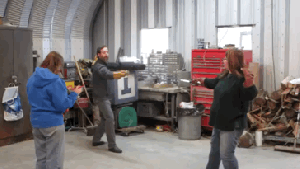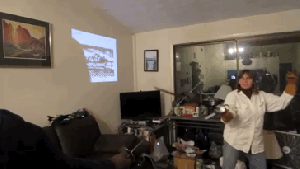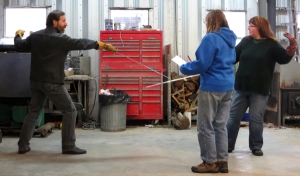With spring coming (eventually) I look forward to swinging around swords and fire without so much hazard and clothing. But winter does lend itself to sitting down, reading manuals and doing some interpretation and scholarship. This generally leads to some peer review, some plays from history and if we’re lucky, a shared class and a new demonstration for the historical show.

Earlier, I’d become sick of driving 30+ miles each way for a group that meets in Cambridge, MA at MIT. It’s a good group but it was wearing on me. I asked “Why can’t we have a group that meets nearby? (and if you’ve driven in MA, you know why we are called M*SSholes) So we started Worcester Historical Oral Martial Practitioner’s Study (yes, that spells WHOMPS) It’s a few friends, Fenix and me in various backyards and living rooms going through facsimiles and translations. (Outrageous and non-period correct costumes optional)
Recently someone made a general inquiry and I told her
“It mostly takes enthusiastic people, some source material and a living room with a high ceiling”
Really and truly that is your primordial ooze of historical European martial arts.
“It mostly takes enthusiastic people, some source material and a living room with a high ceiling”
Really and truly that is your primordial ooze of historical European martial arts.
Here’s how we did it-we picked a manual from here:
http://www.umass.edu/renaissance/lord/collection.html
http://www.umass.edu/renaissance/lord/collection.html
Then we looked at some online translations and did our best to kluge through and make sense of it all. This involved calling in favors with people who spoke and wrote French, asking some folks familiar with smallsword and taking our best guess.
From there, we did approximately 1-2 sections per session. This involved having the English, our friend’s notes from our sessions, a projected image and an out-loud reader. Ideally you’d have a minimum of three people. We are fortunate to have four so we can swap out bodies, ideas and readers. I tease our “bodies” and call them “Western Martial Arts Barbie” –that is, the outside observers position them, watch the maneuvers and critique. If you have a thin skin, this part will go poorly for you. And if you have bias regarding another martial arts form-it will show up here. The difficult part is following the manual and not throwing in what you feel. And if you present the material that way to others-prepare to take the heat. I have been at a number of events where an interpretation has been presented and the speaker was stunned when the material was skinned, gutted and held over an open flame (figuratively) If you try to cite your material and can’t find the relevant piece of reference, then it’s not really using the source material, it’s just making stuff up. And there are plenty of people with internet-bought blades slicing milk jugs and posting it on YouTube, thank you.


But you need people who are good at physical interpretation to balance your scholars. Because many treatises are fairly obscure and vague, sometimes there will be a position shown, a description and a WTH finish with no explanation. Bridging that gap is where the understanding of bodies, blades and geometry comes into play. I know a couple of people with a fantastic grasp of this-and they are still often wrong on the first go around. Sometimes you will not come to an agreement within the group and you have to agree to move on and revisit it another day. No one gets it on the first try. Sadly we can’t reanimate these sword masters and ask what it was they *really* meant, we can only do our best guess with what they have left us. And there are similarities-in all martial arts-bodies move in limited ways, but we have to make sure it is physics, not slipping in some other form. An analogy might be using frog DNA to create dinosaurs, and we all know how that turned out….
Reproducible results is one of the tricky points. This is my strength-I am the one with the dumb look on my face who says
“I don’t get it.” And I am willing to do it over, and over and over, and over until it is clear to me. And very often watching me struggle with something will illuminate that it is just a bad idea. It’s a gift, I know. And I might need someone to say that “It’s like George Silver” or a similar “maneuver in Swetnam” to get it. And there is nothing like teaching it to others to blow holes in all these nice interpretations and theories. Which brings me to;
“I don’t get it.” And I am willing to do it over, and over and over, and over until it is clear to me. And very often watching me struggle with something will illuminate that it is just a bad idea. It’s a gift, I know. And I might need someone to say that “It’s like George Silver” or a similar “maneuver in Swetnam” to get it. And there is nothing like teaching it to others to blow holes in all these nice interpretations and theories. Which brings me to;
Peer review, a key part to making sure you have done it correctly. I am not saying that more advanced sword users are always right-in fact, it’s good to question them and their opinions. Like you, they have to be ready to back the horse they rode in on and cite sources and show and tell. “Because I said so” only works with your parents, not with your peers. If your work can’t stand this scrutiny, then it isn’t good work. I’m not saying that it is not discouraging or that you have to take what others say as gospel, but it IS good to take an additional look at your work. Sometimes we are too attached, or too close to our interpretation to see its flaws. A practitioner I respect very much was asked about a change he made in some teaching material and he had to admit he’d thrown some 19th century boxing techniques into the class, and had to admit that then the play was not a direct interpretation and should not be represented as part of the original material. Everything was all better over beer.
One of my favorite parts of continued work with weapons manuals-beer (after sword work) and camaraderie. Like any accomplishment, when you receive kudos for it, it’s great to share those accolades because in the wider world, that will not be forthcoming. But when others in your sword community admire solid work, that makes it worthwhile. Different weapons will have different distances, stances, techniques and speeds. One will not use a poll arm like a dagger or a longsword like a cudgel (usually.) It can be maddening to see individuals dismissing the differences. The whole “to a man with a hammer, everything looks like a nail,” people. They make me a little crazy and it’s disrespectful. So if you are someone at a renfaire and you make fun of people who have done more research and then quote Wikipedia at me-in my mind I am sending you to a special hell. And other uncharitable thoughts. But the bright side was that a German manuals scholar recognized our work at a faire-he rocked our world AND he wanted us to clarify the manual year. We are still talking about that to this day. So it’s not a big segment of the population but some people can appreciate and recognize flavors of swordplay.
The last thing I have to say about this is that you don’t have to be a snob about it. I will *gladly* and *gently* talk about swords with anyone who wants to discuss them. Manual interpretation is not sport fencing, it is not sparring (although information can cross those borders) and it’s not SCA fighting. It is its own creature and we are all better off discussing it in context. I would love to bring more people, regardless of physical skill into more historical research but it is not for everyone. It’s time consuming, problematic and riddled with as many alpha personalities as any other interest. And it’s not for us to judge how it is used. A number of our stricter friends joke with us about translating it into performance pieces-but adding an entertainment element gets it to a wider audience. One member became the dreadnought of his Live Action Role-Playing group using a historical ward he learned with us-so you never know where the information will lead or how it will play out in the big picture.
But if it sounds like something you’d want to do-here are some links (not exhaustive, just some suggested)
But if it sounds like something you’d want to do-here are some links (not exhaustive, just some suggested)
For Manuals
http://www.wiktenauer.com/
http://www.wiktenauer.com/
Membership gives access to manuals
http://www.ahfi.org/
http://www.ahfi.org/
Finding interested parties locally: (free to join)
http://www.swordforum.com/forums/forum.php
http://www.swordforum.com/forums/forum.php
Or, as always please feel free to contact me-phoenixswords@gmail.com




No comments:
Post a Comment